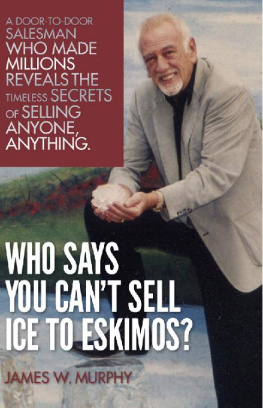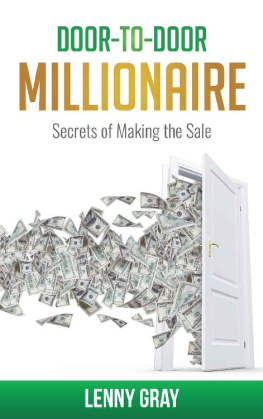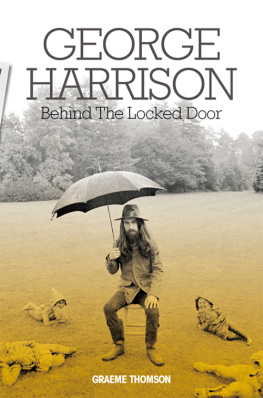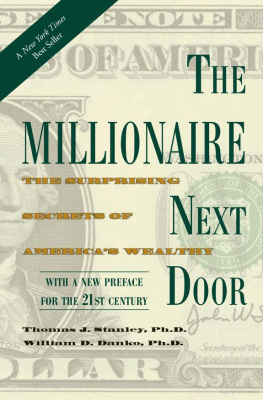WHO SAYS
YOU CANT SELL ICE
TO ESKIMOS?
A Door-to-Door Salesman Reveals
the Timeless Secrets of Selling
Anybody, Anything
by
James W. Murphy
James W. Murphy, James D. Murphy, and L. Douglas Keeney, 2014
All rights reserved. No part of this document may be reproduced or transmitted in any form or by any means, electronic, mechanical, photocopying, recording, or otherwise, without prior written permission of authors.
Foreword: James D. Murphy
Edited by L. Douglas Keeney
Copyedited by Carl Arnold, www.edit1to1.com
Cover Design: Lone Red Design, www.lonered.com
Photos courtesy: The Author
For bulk copies contact:
www.douglaskeeney.com
ISBN-13: 978-1490365251
ISBN-10: 1490365257
eBook ISBN: 978-1-63003-438-2
Library of Congress Control Number: 2013910375
CreateSpace Independent Publishing Platform
North Charleson, SC
James W. Murphy
Brief Biography
Born on August 5, 1938, in Lexington Kentucky, Jim Murphy has spent a lifetime pursuing the skills of the sale. He started his career as an IBM salesman in the North Florida territory selling the IBM Selectric typewriter, which dbuted in the early 1960s. Jims outstanding performance as an IBM salesman caught the eye of the Florida branch manager for World Book Encyclopedia, owned by the Field Enterprises Corporation.
This is where Jim spent the bulk of his selling career as a door-to-door salesman, eventually breaking records and establishing himself as a successful branch manager. He earned the companys highest awards in all categories individual selling, service, recruiting and branch management. Some of his achievements at World Book included: the Superior Service Key Award, the Tree of Life Award (the companys highest award for superiority in recruiting), the division managers Flying Circus recipient (the companys highest overall sales honor) and an appointment to World Books Presidents Advisory Council.
Jim hired and trained over a thousand salespeople, a significant accomplishment for any company. He then took over branch operations in Kentucky, where his team consistently drove more than $5 million in sales revenue each year until he retired at the early age of 51. He then invested in the Toshiba copier and facsimile dealership in this area of the country and quickly grew that business into four offices and over eight million dollars in annual sales. Jim sold that company in the late 1990s and retired to his horse farm in Shelbyville, Kentucky.
Contents
Introduction
by James D. Murphy
My father was from the last great generation of salesmen. He grew up in the scotch and cigarettes era, doing the least glamorous job in America: door-to-door sales for IBM, World Book Encyclopedia, and later on, Toshiba. It wasnt flashy work, but he loved it, and he made a great life for my mom and my sisters in Shelbyville, Kentucky. We eventually settled on a horse farm that was paid for one fifty-dollar commission at a time, one five hundred-dollar sale at a time, five million dollars in sales a year. Thats a lot of money, but thats a lot of selling too.
Dad loved it. He knocked on tens of thousands of doors and pitched in the living rooms of American families in Florida, Massachusetts, Ohio, Indiana, and Kentucky. Selling was something he had a gift for but, like the rest of us, he had to learn some skills too. His indoctrination came in 1963 at IBM. At that time, it was probably the best sales force in the world. From getting past the secretaries to closing with the boss, they taught him how to sell typewriters and office equipment long before you bought those things in a grocery cart at Target or Best Buy.
Dads boss at IBM had a client who was a dynamic guy with a yacht in Florida who owned the World Book franchise for the entire state. This person was good for an IBM machine or two a year, but Dad was hungry for more and he saw what was going on down there with encyclopedias. It didnt happen overnight, but in 1969, Dad called him and said he wanted to get on board with World Book. He stuck with it for the next twenty-two years.
At that time, World Book was a national organization subdivided into seventy-three different branches, including the one Dad eventually owned in Kentucky. World Book had thousands of people going door-to-door every day. Their collective experience refined the sales process into an exact science. It was paint-by-numbers, sell-by-numbers. Every action had an equal and opposite reaction that got you closer to yes. What if the dad answers the door? What if mom answers? If the kids are in the room for the sales pitch, how do you keep them interested?
World Book had wormholes and alleyways for every possible direction a conversation might take. It was a script that the company had perfected over decades, and my dad having not only sold himself, but having trained hundreds of other salesmen knew it cold. He knew the objections, he knew the value propositions, and he could tell by the way you turned a books pages whether you were ready for the close or not.
He developed an eye for detail that kept him two steps ahead of every sale. He knew the tricks that you can learn only on the pavement, going door-to-door for a lifetime. He made a sport out of it. It was always fun. It was always a mental game. I remember him at dinner, often talking about how to navigate this puzzle, this psychological puzzle that was called the American family. Twice he won World Books highest award the Flying Circus the MVP award for the entire company. And when he was tired of selling encyclopedias, he started his own company selling copiers, and then sold it for seven million dollars.
World Book became part of our family. I grew up thinking prospect, canvas, cold call, close. You closed the deal, you got paid. A true rip em and stick em mentality. As a young kid, he gave me How to Win Friends and Influence People one of the original editions. It was an old, dusty hardback. He was always a big reader of books on selling.
Dad carried his A Volume everywhere. When you signed on as a World Book salesman, they gave you this nice briefcase, and in it was the A Volume. The thickest volume in the set of 22, it was the demo volume. So it had more science, more detail in it than the others. We always had a full set of World Books in the house. He believed in the product so much that he referred any dinner conversation right back to it. Go look it up, son, was his answer to most questions, and then Id have to scour the house for whatever spine-creased volume we needed inevitably under someones bed or the kitchen counter before the conversation could move on.
His instruction didnt stop there. Each of his three kids including me was raised on the art of selling. It was like learning to catch a ball. From an early age, we knew Dads five-step process: you prospect, you canvas your territory, you cold call, you demo, and you close. No appointments, no call-backs, and no gimmicks. When we became salesmen ourselves, we already understood that orders came only when wed executed each of these five steps.
Dad had a passion for teaching teaching the art of pitching and closing and thats what this book is mainly about. He trained and hired every single person who ever worked for him. His passion was for delivering sales training salespeople and showing them the art of selling and closing. See, Dad knew that if you could get the script right, if you could learn the territory, and if you could handle the inevitable rejection, then it was only matter of time before you got to yes. That was the promise he made to every salesman he ever hired a promise he backed up with his own cash. Do it right and do it a lot, and the money will come. If not, Dad would write you a check for the commission that the numbers said you should have made. Thats how deeply he believed in a disciplined sales process.
Next page






